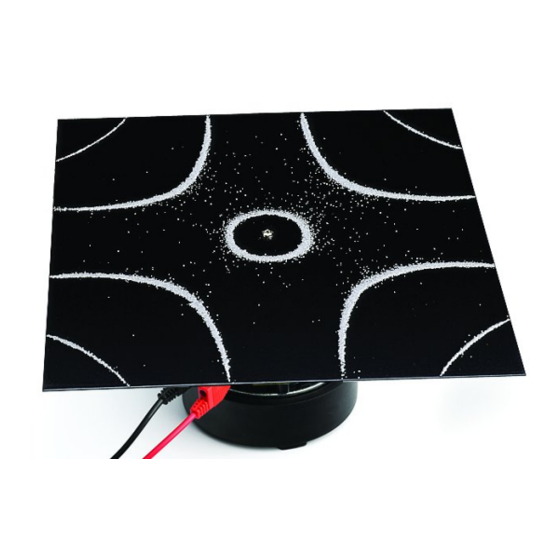
Advertisement
Quick Links
Introduction
A string vibrating at a resonant frequency develops a standing
wave pattern consisting of regularly spaced nodes (points on the
string that do not vibrate) and antinodes (points where the
amplitude of vibration is a maximum). More interesting standing
wave patterns are created with vibrations in media that support
wave propagations in two dimensions, such as a metal plate or a
drum head.
In the early nineteenth century, Ernst Chladni developed a
technique for investigating two-dimensional wave patterns. Sand
is sprinkled onto a plate, and a violin bow is used to vibrate the
plate. The sand comes to rest on the nodal lines, where no
vibration occurs. Sand that is not resting on a nodal line gets
bounced around until it finally lands on a nodal line and comes
to rest.
When used with the PASCO Wave Driver (WA-9855), the
Chladni Plate improves on Chladni's original method, allowing
you to produce steady plate vibrations at any desired frequency.
The illustration below shows an example of the nodal patterns
that can be created.
NOTE: The Chladni Plate can also be used with
the Mechanical Wave Driver (SF-9324). A
banana plug is included with the Chladni Plate
as legacy support for connecting the plate for
the Mechanical Wave Driver. However, the Wave
Driver (WA-9855) is strongly recommended for
experiments with the Chladni Plate.
Equipment
Included equipment:
• Chladni Plate
• Banana plug
• Nut
• Washer
• Lock washer
• Long screw (6-32 × 1-3/8)
• Short screw (6-32 × 1/4)
• Sand shaker
• Extra fine sand (1 kg)
Chladni Plate
(WA-9406)
.
NOTE: You may also receive a solder tab
alongside the other components. This
component should be discarded, as it is not
used in the operation of the Chladni Plate.
Other required equipment:
• Wave Driver (WA-9855)
• 2× Banana Plug Patch Cords (SE-9751)
• Any of the following function generators:
- 850 Universal Interface (UI-5000)
- 550 Universal Interface (UI-5001)
- Sine Wave Generator (WA-9867)
- Function Generator (PI-8127)
Using the Chladni Plate
Connecting the plate to the Wave Driver
Connecting to the Wave Driver (WA-9855; recommended):
1. Insert the long screw into the hole in the center of the plate.
2. Turn the plate over and place the lock washer onto the
screw.
3. Place the nut onto the screw and tighten it until it reaches
the lock washer.
4. Turn the plate right-side-up again and, using a Phillips head
screwdriver, tighten the screw until the nut is locked in
place.
5. Insert the screw into the drive post of the Wave Driver.
6. Rotate the plate clockwise to screw it in until it cannot
easily rotate any further. Tighten the screw using the
Phillips head screwdriver to secure the plate in place.
Connecting to the Mechanical Wave Driver (SF-9324):
1. Insert the short screw into the hole in the center of the
plate.
2. Turn the plate over and place the washer onto the screw.
3. Place the banana plug onto the screw and rotate clockwise
until it reaches the washer.
4. Turn the plate right-side-up again and, using a Phillips head
screwdriver, tighten the screw until the banana plug is
locked in place.
5. Insert the banana plug into the drive post of the Mechanical
Wave Driver.
Product Guide | 012-17474A
1
Advertisement

Summary of Contents for PASCO WA-9406
- Page 1 - Sine Wave Generator (WA-9867) to rest. - Function Generator (PI-8127) When used with the PASCO Wave Driver (WA-9855), the Chladni Plate improves on Chladni’s original method, allowing Using the Chladni Plate you to produce steady plate vibrations at any desired frequency.
- Page 2 Trademarks interesting to experiment with other materials. PASCO and PASCO scientific are trademarks or registered trademarks of PASCO scientific, in the United States and in other countries. All other brands, products, or service names are or may be trademarks or service marks of, and are used to identify, products or services of, their respective owners.















Need help?
Do you have a question about the WA-9406 and is the answer not in the manual?
Questions and answers